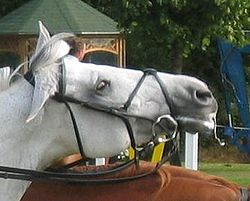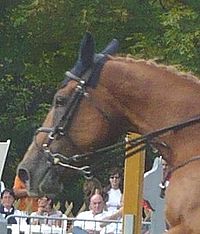
Gag bit
Encyclopedia

Bit (horse)
A bit is a type of horse tack used in equestrian activities, usually made of metal or a synthetic material, and is placed in the mouth of a horse or other equid and assists a rider in communicating with the animal. It rests on the bars of the mouth in an interdental region where there are no teeth...
for a horse
Horse
The horse is one of two extant subspecies of Equus ferus, or the wild horse. It is a single-hooved mammal belonging to the taxonomic family Equidae. The horse has evolved over the past 45 to 55 million years from a small multi-toed creature into the large, single-toed animal of today...
. With two sets of reins, the gag bit gives a rider the ability to use either a standard direct action or a gag action. In this, the gag bit is related to a Pelham bit
Pelham bit
A pelham bit is a type of bit used when riding a horse. It has elements of both a curb bit and a snaffle bit. In this respect a pelham bit functions similar to a double bridle, and like a double bridle it normally has "double" reins: a set of curb reins and a set of snaffle reins. Because it has...
and a double bridle
Double bridle
A double bridle, also called a full bridle or Weymouth bridle, is a bridle that has two bits and four reins . One bit is the bradoon , is a modified snaffle bit that is smaller in diameter and has smaller bit rings than a traditional snaffle, and it is adjusted so that it sits above and behind the...
. Unlike these, however, the gag bit has no curb strap.
Some styles of gag bit are integral to a special bridle, known as a gag bridle; others are used with a standard bridle. Inside the horse's mouth, the gag bit may be jointed like a snaffle bit or smooth like a Mullen mouth bit.
Usage
The gag bit works on the horse's lips and pollPoll (horse)
The poll is a name of the part of an animal's head, alternatively referencing a point immediately behind or right between the ears. This area of the anatomy is of particular significance for the horse....
simultaneously. The pressure on the lips tends to make the horse raise its head, which is useful for a horse that tends to lean on the bit. Gag bits are used mainly for horses that are strong pullers or for horses that need retraining. Gag bits are most commonly seen in polo
Polo
Polo is a team sport played on horseback in which the objective is to score goals against an opposing team. Sometimes called, "The Sport of Kings", it was highly popularized by the British. Players score by driving a small white plastic or wooden ball into the opposing team's goal using a...
, eventing
Eventing
Eventing is an equestrian event comprising dressage, cross-country, and show jumping. This event has its roots in a comprehensive cavalry test requiring mastery of several types of riding...
(especially for cross-country), show jumping
Show jumping
Show jumping, also known as "stadium jumping," "open jumping," or "jumpers," is a member of a family of English riding equestrian events that also includes dressage, eventing, hunters, and equitation. Jumping classes commonly are seen at horse shows throughout the world, including the Olympics...
, and hacking, mainly for increased control at times where a horse may be excited or try to run off with the rider.
They can also be used to help elevate a horse that is heavy on its front end.
They are not permitted at any level of dressage
Dressage
Dressage is a competitive equestrian sport, defined by the International Equestrian Federation as "the highest expression of horse training." Competitions are held at all levels from amateur to the World Equestrian Games...
, since dressage riders are trying to get the horse to come down onto the bit
On the bit
The phrases "on the bit", "behind the bit" and "above the bit" are equestrian terms used to describe a horse's posture relative to the reins and the bridle bit. A position on the bit is submissive to the rider's rein aids, given through the bit. When a horse is behind the bit, the head is tucked...
, and want to encourage the horse to accept contact. Additionally, the horse is supposed to be completely submissive in dressage, and a gag bit gives the impression that it is not. Gags are also never seen in the hunter arena, again because they wish to portray that the horse is an easy ride, and because they want a long, relaxed frame with the neck stretched out, rather than a high neck.
Gag bits are also occasionally seen in western-style competition, usually in the form of a sliding mouthpiece on a shanked curb-style bit (similar to the American gag).
The gag bit normally is used with two sets of reins; one on the bit ring
Bit ring
The bit ring is the ring on the side of a horse's bit, particularly on a snaffle bit. It is used as a point of attachment for the cheekpieces of the bridle and for the reins. It also has an effect on the action of the bit...
that does not apply gag leverage, and the other on the small ring attached to the cord or rolled leather strap of the gag bridle cheekpiece. This allows for the bit to be used as a normal snaffle, with gag action used only when needed. Polo players, who must ride with the reins in one hand and cannot make instant fine adjustments, often use a gag bit with draw reins.
Types of Gag Bits

- Gag Snaffle: http://horsecrazy.co.za/catalog/images/Dsc01340.jpghttp://www.yale.edu/polo/Photo_Gallery/Alumni_Weekend__02/will_on_horse.jpg similar in shape to a snaffle, with a mouthpiece and a ring on either side. Each bit ringBit ringThe bit ring is the ring on the side of a horse's bit, particularly on a snaffle bit. It is used as a point of attachment for the cheekpieces of the bridle and for the reins. It also has an effect on the action of the bit...
has two holes: one on the top and one on the bottom. Gag cheekpieces, made of rounded leather or of rope, are run through these holes. The end on these cheekpieces, after passing through both holes, have a metal ring to which the reins are attached. When rein pressure is applied, the bit slides upward and rotates slightly in the mouth. Severity is determined by the ring size: the larger the rings, the more severe the gag. The gag snaffle includes the Balding gag, which has a loose-ring design, and Cheltenham gags which have an eggbutt design.
NOTE: The "gag snaffle" is not a snaffle bit (although it has the option of acting like one if the rider only attaches a rein to the bit rings, and not to the sliding gag cheekpieces).
- Elevator:http://www.quickbits.net/Optimized300/76_horse.jpg consists of a snaffle mouthpiece with cheeks or shanks attached to the side. The upper shank has a hole to attach the cheekpiece, and the lower shank has several holes to attach the rein. The lower the rein is placed on the shank, the more severe the leverage. When rein pressure is applied, the bit rotates in the mouth and places pressure on the poll, as the upper shank moves forward, as well as on the lips.
- Dutch/Continental/Three-Ring/Four-ring/Pessoa gag: Similar to the elevator, except the cheekpieces consist of stacked rings. There is usually only one ring above the mouthpiece, to which the cheekpiece is attached. The ring below that is attached straight to the mouthpiece, and acts similarly to a snaffle. The lower ring(s), of which there are usually two, are for a second rein to be attached, and they provide the gag action. The lower the second rein is placed on the stack, the more "leverage" (raising of the mouthpiece up along the cheekpiece) is applied. Dutch gags are useful because they provide options for the severity of the bit. The bridle cheek pieces are attached to the top rings to produce pressure.the lower the reins are fitted, the stronger the leverage action on the horses mouth.

- American Gag: http://www.horse-tack-and-equestrian-clothing.com/assets/product_images/thumbs/AC_4_69.jpg has the shape of an "H". It has one ring on the upper shank, to attach the cheekpiece of the bridle. There is a lower shank, for the gag rein, and a middle loop to which it is possible to attach a snaffle rein. The mouthpiece has the ability to slide up the curved sides of the bit as the reins are taken up, putting pressure on the corners of the mouth and encouraging the horse to raise his head. Unlike the Dutch gag, the American gag does not offer options for the height the reins may be attached. The American Gag bit applies pressure to the poll of a horse's head, to gain greater control of the horse. Using this bit for greater control should only be used as a last resort.
- Half-ring/Duncan gag: http://www.wrwestern.com/BITS77%20Bit,%20Snaffle%20Hunting%20Gag.JPG a particularly severe type of gag. Similar to the snaffle gag, except it has a half ring. The ring ends have holes, through which the cheekpieces run. Unlike the snaffle gag, however, there is no connection between these two holes to the outside of the bit, so only the gag rein can be used (if two were used, the snaffle rein would have to attach to the rounded cheekpieces).

